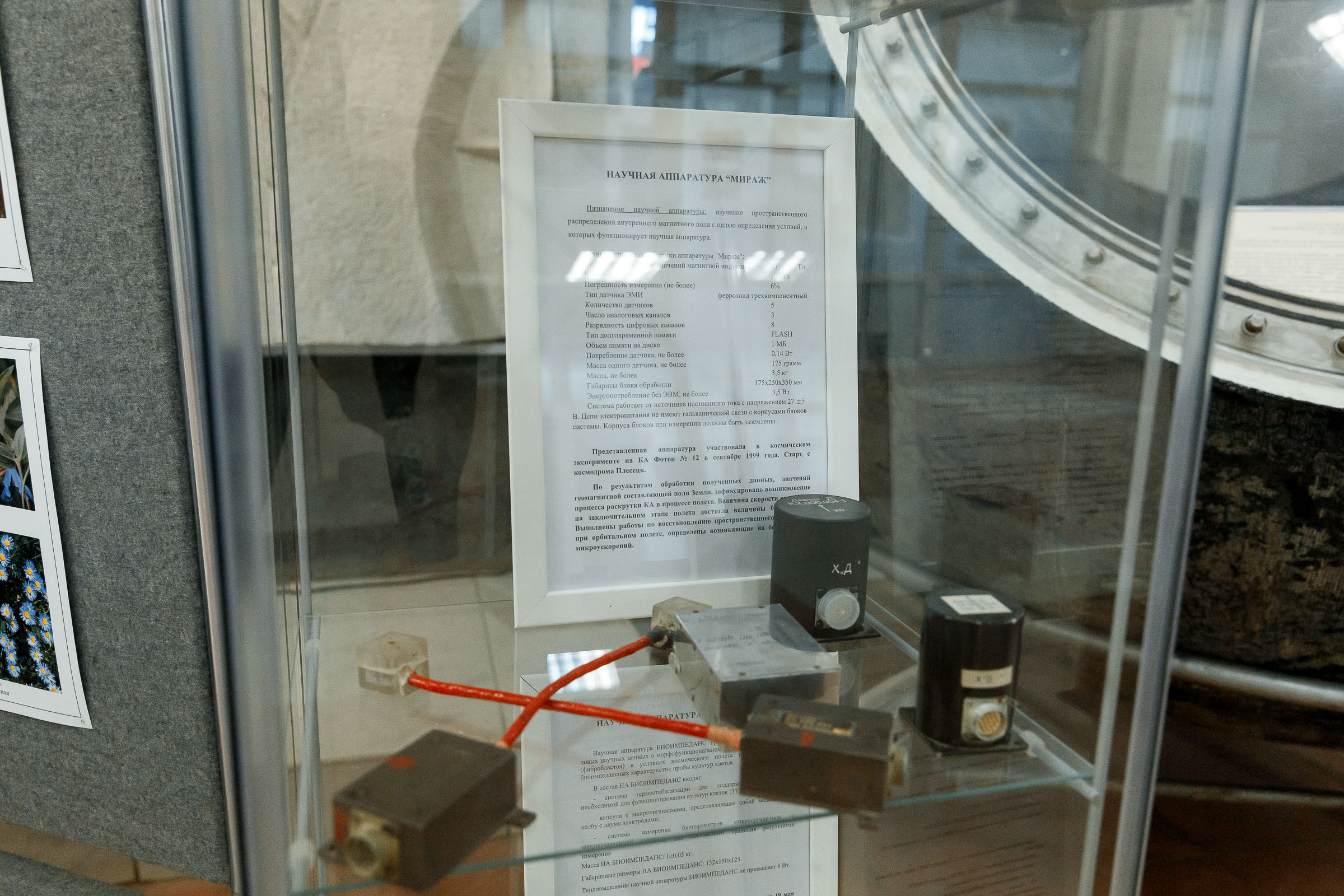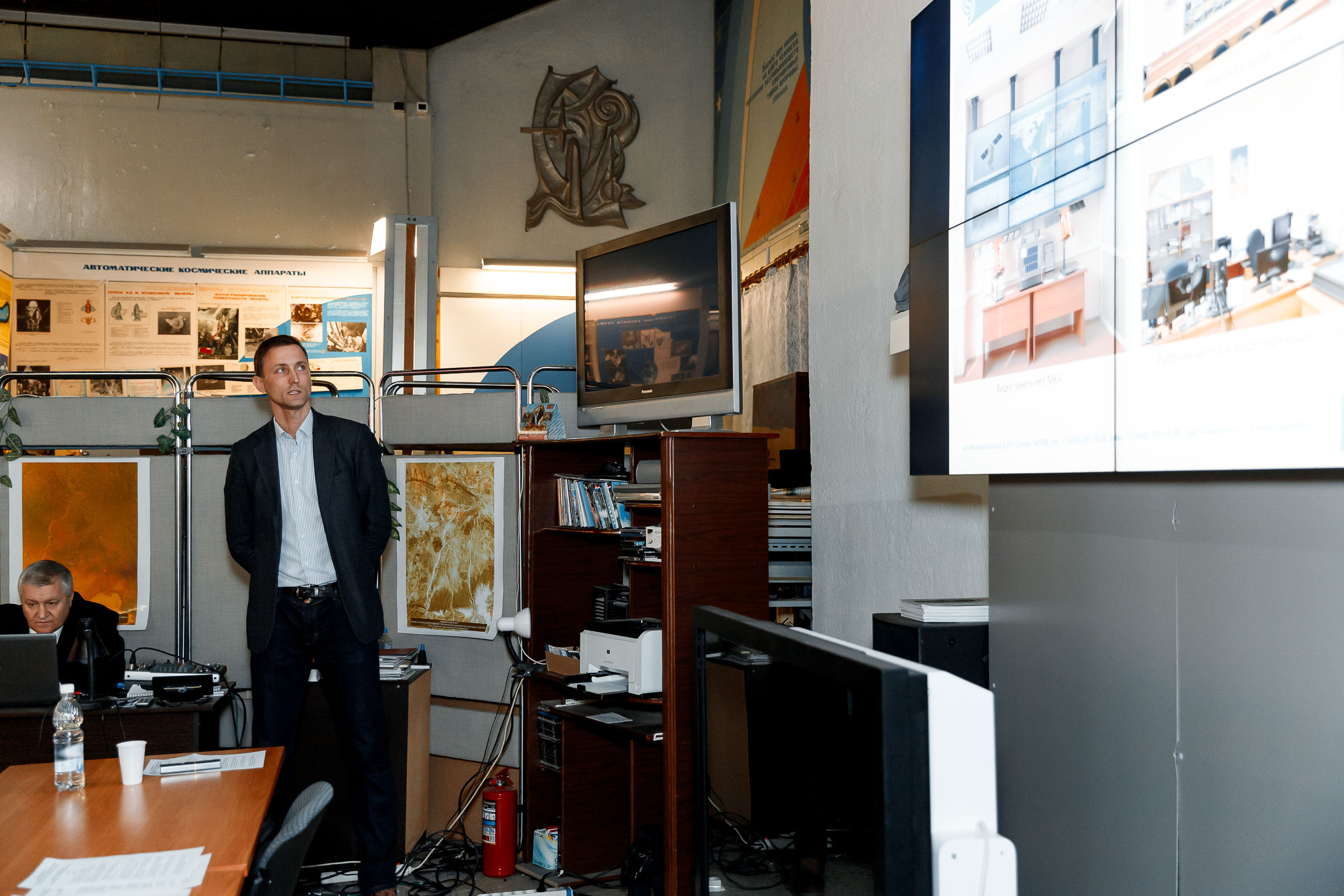I.S. Tkachenko, Director of Institute of Aerospace Engineering, and A.D. Storozh, Adviser to the CEO of RSC “Progress” JSC, addressed their welcoming speeches to the participants in the Readings. N.V. Bogdanova, Director of the Museum of Aviation and Cosmonautics, presented the Exhibition “Biological Laboratory in Orbit”, in which rare materials from the museum’s collections and new arrivals – photographs provided by the RAS Institute of Biomedical Problems, RSC “Progress” JSC, as well as university staff who participated in implementation of the program “Biosputnik”, were published for the first time. The participants were particularly interested in samples of scientific equipment created by the University’s scientific departments, as well as rare plants of the Samara Region to have been in space, exhibited on board the spacecraft “BION-M” No. 1 and provided by the University’s Botanical Garden.
The Readings participants – students and university staff – had a unique opportunity to learn firsthand details of preparation and implementation of the unique program of biomedical experiments on specialized spacecrafts of the “BION” series.
The Readings were opened by Valery Ivanovich Abrashkin, permanent Head of the Design Department of the TSSKB, which was engaged in developing spacecrafts “Bion”, “Photon”, and now Associate Professor at the D.I. Kozlov Department of Space Engineering. He told the audience the history of creation and main results of flights of the spacecraft series “BION” and “BION-M” No. 1. Specific features of work progress on the space complex “BION-M” No. 2 for conducting fundamental research in space biology and medicine were noted in the speech by N.B. Gubin, a representative of the RSC “Progress”. A.D. Storozh also made interesting additions and explanations to the audience. According to him, launching the spacecraft “Bion-M” No. 2 is planned to be carried out in 2024. As part of its scientific equipment and experiments, developments made by scientists from Samara University are also provided for.
K.E. Voronov, Director of the Institute of Space Instrumentation (ISI), spoke in detail about the history of creating and developing his scientific department, equipment for the spacecrafts “BION” and “Photon”, as well as promising projects and experiments. The scientific equipment “Bioimpedance” created at the ISI was used to study behavior of biological microobjects in space conditions, and the scientific equipment “Graviton” allowed reconstructing rotational motion of the spacecraft “Bion-M” No. 1. Konstantin Evgenievich remembered with special warmth about the founder of the institute, Professor N.D. Semkin and his works. Associate Professor at the Department of Space Engineering Yu.Ya. Puzin spoke about developing software and hardware for monitoring the microgravity situation on board the spacecrafts “Bion-M” and “Photon-M”.
S.L. Safronov, another representative of the Department of Space Engineering, presented his report “The spacecraft “AIST” as related payload as part of the spacecraft “Bion-M”” .
Yu.N. Gorelov, Director of Research Institute for Modeling and Control Problems (NII-310), presented the detailed report on participation of Samara universities and other scientific organizations in the scientific programs “Bion-M” No. 1 and “Photon-M” No. 4. Created at NII-310, the scientific equipment “Carbon” and the experiment with the same name allowed exploring influence of space-factor impact on stability of silicon carbide structures when exposed in open outer space. Scientific staff of Samara State Medical University and N.M. Tulaikov Research Institute of Agriculture also took part in organizing and conducting experiments at the spacecraft “Bion-M” No. 1 .
At the end of the Readings, E.A. Kayurova, agronomist of the Flora Department of the Botanical Garden, made her report “Analysis of features of post-flight development of plants of natural flora obtained from seeds exposed at the spacecraft “Bion-M” No. 1” . Her interesting and informative report was accompanied by unique illustrations “from the life of plants” in the University’s Botanical Garden.
The Readings were held in a very warm, informal atmosphere and aroused great interest among the listeners, who were able to ask questions to direct participants of the “BION” program. In course of preparing the Readings, the museum’s exposition and funds were replenished with new materials reflecting the history of the project “BIOSPUTNIK”, contribution of Samara enterprises and university scientists to its implementation and development. Following the Readings results, it is planned to release a popular science film, as well as a small exhibition at the Museum of Aviation and Cosmonautics.
Photo by Olesya Orina
 RU
RU  EN
EN  CN
CN  ES
ES 




















